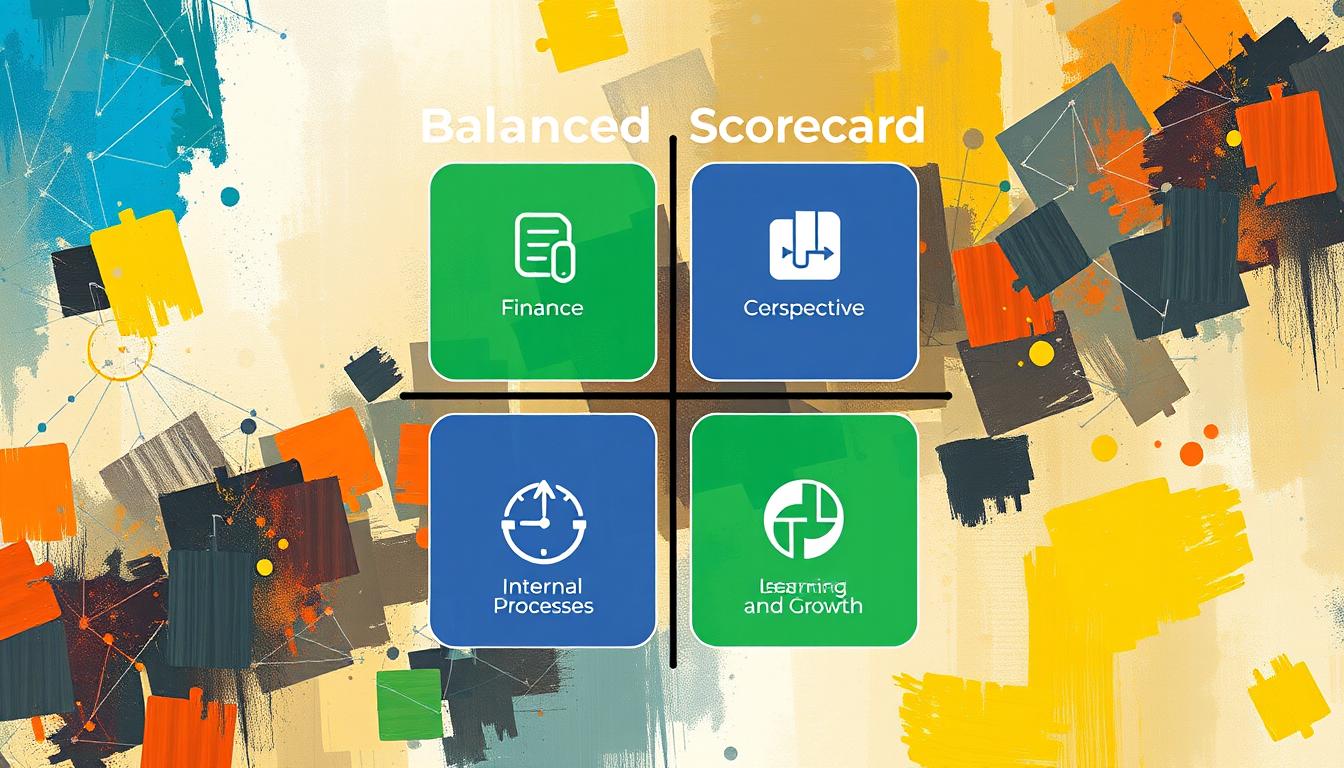Imagine a business world where strategy and structure work together perfectly. This is what the McKinsey 7S Framework offers. It has helped many organizations deal with change1.
The McKinsey 7S Framework was created by McKinsey & Company in the 1970s. It looks at seven key areas: Strategy, Structure, Systems, Shared Values, Skills, Style, and12. It shows how these elements must work together for success. This includes executing strategies well, improving performance, and handling big changes like mergers1.
Key Takeaways
- The McKinsey 7S Framework is a powerful tool for aligning organizational strategy with structure.
- It examines seven interconnected elements: Strategy, Structure, Systems, Shared Values, Skills, Style, and Staff.
- The framework emphasizes the importance of aligning all seven elements to achieve organizational effectiveness and manage change successfully.
- Potential use cases include implementing new strategies, improving organizational performance, navigating mergers and acquisitions, and driving cultural transformation.
- Organizations must analyze each element and identify areas of misalignment to effectively apply the McKinsey 7S Model.
Understanding the Origins and Evolution of McKinsey 7S Framework
The McKinsey 7S Framework started in the 1980s. It was created by a team at McKinsey, including Tom Peters and Robert Waterman3. This model changed how we think about organizations. It focuses on how different parts work together for success3.
Development by McKinsey Consultants
In the early 1980s, the framework was born at a San Francisco retreat. Tom Peters, Bob Waterman, and others came up with it4. It has seven parts: Strategy, Structure, Systems, Shared Values, Style, Staff, and Skills. These must work together for the best results34.
Historical Context and Business Impact
The McKinsey 7S Framework came out when companies needed to adapt. It showed how important people are for success. This model helped companies tackle their challenges3.
Evolution Through Modern Business Era
Over time, the McKinsey 7S Framework has grown. It’s now a key tool for change management. It helps companies see how changes affect them. Its lasting value shows it’s great for new strategies and growth34.
“The McKinsey 7S Framework emphasizes that all elements should be given equal importance to achieve optimal results in organizational alignment and effectiveness.”
McKinsey 7S Framework: Aligning Strategy with Structure
The McKinsey 7S Framework shows how seven key elements work together for success. These are Structure, Strategy, Systems, Skills, Style, Staff, and Shared Values. It’s all about looking at every part of a company to make a strong strategy5.
At the core of the 7S Model is Shared Values. They guide how the company acts and makes decisions6. When these values match across all areas, a company can build a strong culture. This culture supports the company’s goals and helps with change5.
- The model shows that “hard” and “soft” elements must work together for change5.
- Starting with Shared Values is key in the McKinsey 7S Model. It sets the stage for aligning other elements5.
- Using the 7S Model helps find and fix problems in a company. It’s a way to check design, alignment, and performance5.
- To use the 7S Model well, a company must plan for change. They need to execute the plan, check progress, and adjust as needed5.
By using the McKinsey 7S Framework, companies can handle change better. They can keep everything aligned, from culture to leadership6.

“The McKinsey 7S Model helps see how change affects the whole company. It also helps map different changes in complex situations.”
Hard Elements: The Structural Foundation of Change
The McKinsey 7S Framework focuses on the “hard” parts: Strategy, Structure, and Systems. These elements are the backbone for business change and design7. When these hard parts are in sync, companies can build a strong base for growth and success.
Strategy Development and Implementation
The Strategy part of the 7S model is the plan for winning in the market7. It outlines the company’s goals and how to reach them. Good strategy planning is key to success, making sure everything works together for the best results8.
Organizational Structure Analysis
The Structure part looks at how the company is set up, from top to bottom7. Leaders can spot ways to improve by analyzing the current setup. This is vital for making sure everyone knows their role and how to make decisions8.
Systems and Processes Integration
The Systems part deals with how the company runs, from data to decisions7. Making these systems work together helps teams work better and makes decisions smarter8. This part is about using technology to boost productivity and efficiency.
The hard parts of the McKinsey 7S Framework are key for business transformation, organizational design, and strategy execution. By aligning these elements, companies can create a solid base for growth and stay ahead in the market9.
Soft Elements: The Human Side of Organizational Change
The Soft Elements of the McKinsey 7S Framework include Shared Values, Skills, Style, and Staff. These are the intangible, culture-driven parts of an organization1. They are key for successful change because they affect how employees behave and the corporate culture10.
Shared Values are the core principles that guide the organization10. Skills are the abilities and knowledge of employees, important for staying competitive10. Style is the leadership approach and management practices, with transformational leaders more open to change11. Staff includes all decisions about hiring, training, and motivation, which greatly affects employee engagement11.
“The soft elements of the McKinsey 7S model are the foundation for successful organizational leadership alignment and change management.”
When analyzing the Soft Elements of the McKinsey 7S model, a gap analysis is often used10. This helps find where the Soft Elements might not be aligned. It lets organizations focus on fixing these issues and make plans for better alignment1.

The Soft Elements of the McKinsey 7S Framework are vital for lasting change in an organization11. By aligning these elements, leaders can build a culture that encourages innovation and success1.
The Role of Shared Values in Organizational Alignment
At the heart of the McKinsey 7S Framework are shared values. These are the core principles that unite an organization. They play a key role in aligning all elements, from corporate culture to organizational effectiveness and leadership alignment12.
Strong shared values are the foundation for effective decision-making. They shape the behaviors and actions of employees at all levels. When an organization’s core beliefs are deeply ingrained, they guide strategic initiatives and the integration of various organizational elements12.
Core Values as Cultural Drivers
Shared values are the building blocks of a company’s corporate culture. They influence how people think, collaborate, and make decisions. By aligning these core values, leaders can foster a cohesive culture that supports strategic objectives12.
This alignment is key during organizational transformation. Shared values drive the necessary behavioral changes.
Impact on Decision Making
When shared values are deeply embedded, they shape how employees view and interpret information. This influences their decision-making process13. Alignment of leadership and employee values ensures decisions are consistent with the company’s strategic direction.
Value Integration Across Elements
Effective implementation of the McKinsey 7S Framework requires integrating shared values across all elements13. By aligning strategy, structure, systems, staffing, skills, and style with core values, companies achieve high organizational effectiveness. This maintains a sustainable competitive advantage.
The alignment of shared values across an organization’s elements is seen in companies like McDonald’s. They have transformed operations and maintained market dominance through a focus on quality, service, and innovation13.
Implementation Strategy for the McKinsey 7S Model
Using the McKinsey 7S framework means aligning your organization’s strategy, structure, and more14. First, you analyze to find gaps and misalignments in these areas14.
After understanding your current state, you plan the ideal design. This involves research and input from stakeholders. A detailed plan is key for strategy implementation and organizational transformation14.
To make changes, you need skilled change management experts. They help ensure a smooth transition. Regular reviews and adapting strategies keep your organization strong and performing well14.
| Key Steps in Implementing the McKinsey 7S Model |
|---|
| 1. Conduct a thorough analysis to spot gaps and misalignments |
| 2. Decide on the best organizational design with research and stakeholder input |
| 3. Develop a detailed plan for changes in each area |
| 4. Carry out changes with the help of skilled change agents or consultants |
| 5. Keep the momentum going with ongoing reviews and adjustments |
By following this method, organizations can manage big changes well. The McKinsey 7S model helps leaders guide their teams through change and success14.
https://www.youtube.com/watch?v=wN9ThF5hsCM
“The McKinsey 7S model helps leaders manage performance, create alignment, handle change, and stay focused on strategy. It’s a connected framework for balancing priorities in leadership decisions at all levels.”
Measuring Success and Performance Metrics
It’s vital to check how well the McKinsey 7S framework works. This is key for improving business results, making the organization better, and executing strategies well15. To do this, track Key Performance Indicators (KPIs) for each of the seven parts: Strategy, Structure, Systems, Style, Staff, Skills, and Shared Values15.
Key Performance Indicators
Organizations need to set KPIs for each part of the McKinsey 7S framework16. For example, Strategy KPIs might be market share, revenue growth, and customer happiness. System KPIs could be about how efficient processes are, how fast things get done, and how many mistakes are made16. Checking these KPIs often helps spot where things are off and what to fix16.
Alignment Assessment Tools
Using tools to check if the seven parts of the McKinsey 7S model fit together is critical17. Tools like SWOT analysis, stakeholder analysis, and employee surveys give a full picture of where things stand16. They help see how well the strategy, structure, systems, and more work together to achieve goals17.
Progress Tracking Methods
Keeping an eye on progress is key to keeping the McKinsey 7S framework working well16. Set up regular check-ins, listen to feedback, and watch for important milestones16. This helps spot where to improve, make changes, and keep the organization on track and ready for changes16.
By using these methods, organizations can track how well the McKinsey 7S framework is doing. This helps keep improving and makes sure it’s helping with business success, making the organization better, and executing strategies well15.
“Effective measurement ensures that the organization maintains alignment across all elements and continues to drive performance improvements.”
Common Challenges and Solutions in Framework Application
Using the McKinsey 7S Framework is tough for many organizations18. It focuses on both “hard” and “soft” elements. This makes it hard to keep everything in sync18.
One big problem is when people resist change18. Employees might not want to change how they work or the structure of the company. This makes it hard to manage change and transform the organization18. Leaders need to create a culture that supports change and explain the reasons behind it well18.
It’s also hard to measure and manage the “soft” parts like culture and skills18. Creating good communication plans and metrics can help align these areas with the strategy18.
- Make sure the leadership team is on the same page about the strategy and the McKinsey 7S Framework’s role19.
- Regularly check for misalignment and adjust the framework as needed18.
- Encourage a culture of ongoing improvement, where everyone can help solve problems19.
By tackling these challenges and using a flexible, data-driven approach, organizations can do better with change management, organizational transformation, and strategy implementation1819.
“The interconnectivity of the McKinsey 7S elements means that a change in one element affects the others, requiring alignment across all elements for successful organizational transformation.”
To succeed with the McKinsey 7S Framework, you need a complete and flexible strategy. Focus on ongoing improvement and really understand your organization’s unique needs19.
Case Study: McDonald’s Successful Implementation
McDonald’s, a global fast-food leader, has always been quick to adapt and change its business model20. They used the McKinsey 7S Framework to improve their organization and grow sustainably20.
Strategic Alignment Process
McDonald’s focused on being cost-effective and set clear goals21. They kept their structure simple, making it easier to manage and make decisions20. They also used new technologies like digital ordering to improve service and customer experience20.
Organizational Transformation Results
McDonald’s emphasized shared values like integrity and community involvement20. They invested in their employees with programs like Archways to Opportunity21. This focus on all seven elements helped McDonald’s stay a top fast-food chain20.
Their leadership style, which involved employees, made the company more effective20. By using the McKinsey 7S Framework, McDonald’s showed it can handle complex challenges and grow over time20.
“McDonald’s has always been a master of organizational transformation, leveraging the McKinsey 7S Framework to stay ahead of the game. Their strategic alignment, culture of shared values, and investment in employee development are truly inspiring.”
| Company | McKinsey 7S Analysis | Key Transformation Outcomes |
|---|---|---|
| McDonald’s |
|
|
Best Practices for Sustainable Implementation
To make the McKinsey 7S Framework work well, you need to keep trying, be flexible, and always look for ways to get better22. Here are some key steps to help you succeed:
- Check all seven parts of the framework – strategy, structure, systems, shared values, skills, style, and staff – often to spot any problems22.
- Build a culture that always wants to improve, where everyone can share ideas and get involved in changes22.
- Keep your leaders in line to push the framework forward and make changes as needed22.
- Work on improving your team’s skills and abilities to help with ongoing changes22.
- Always check and update your strategies to keep up with the market and outside factors, making sure the framework stays useful22.
By sticking to these tips, you can make sure the McKinsey 7S Framework works well for your company. It helps you manage changes and keep your organization strong22.
“The key to successful implementation of the McKinsey 7S Framework is ongoing commitment, adaptability, and a focus on continuous improvement.”
Companies like General Electric, IBM, Naspers, Safaricom, Procter & Gamble, and Standard Bank have used the McKinsey 7S Framework to change and grow a lot23.
The McKinsey 7S Framework is a great tool for checking and matching up your company’s key parts24. It works in many fields, like when companies merge or need to change their plans24. By following these steps, you can make sure the framework works well for your company and keeps your leaders in sync for success22.
Conclusion
The McKinsey 7S Framework is a powerful tool for aligning organizational strategy with business transformation and change management25. It was created in 1982 by McKinsey consultants Robert Waterman and Tom Peters. This framework highlights the importance of seven key areas: Structure, Strategy, Systems, Staff, Style, Skills, and Shared Values25.
Today, the 7S Framework is more important than ever for businesses. It helps tackle the hard and soft sides of an organization26. By checking how these seven areas work together, companies can make plans that lead to lasting change26. Its ability to stay relevant shows it’s a timeless tool for success25.
In the future, the McKinsey 7S Framework will keep helping businesses. It will aid in improving organizational strategy, change management, and business transformation2526. Its detailed approach ensures companies can face today’s challenges and seize tomorrow’s opportunities.
FAQ
What is the McKinsey 7S Framework?
When was the McKinsey 7S Framework introduced?
How does the McKinsey 7S Framework emphasize organizational alignment?
What are the “Hard Elements” and “Soft Elements” of the McKinsey 7S Framework?
How do Shared Values play a central role in the McKinsey 7S Framework?
What are the key steps in implementing the McKinsey 7S Model?
How can organizations measure the success of McKinsey 7S implementation?
What are some common challenges in applying the McKinsey 7S Framework?
How did McDonald’s successfully implement the McKinsey 7S Framework?
What are the best practices for sustainable implementation of the McKinsey 7S Framework?
Source Links
- McKinsey 7s Model Explained: Definition, Components, Steps, Uses, & Examples – https://quantive.com/resources/articles/mckinsey-7s-model
- How to Use the McKinsey 7-S Model for Strategic Planning – https://www.investopedia.com/terms/m/mckinsey-7s-model.asp
- McKinsey 7S Model: The 7S Framework Explained – SM Insight – https://strategicmanagementinsight.com/tools/mckinsey-7s-model-framework/
- McKinsey 7S Framework – https://en.wikipedia.org/wiki/McKinsey_7S_Framework
- McKinsey 7S Model: Importance & How To Use It (2024) – https://www.cascade.app/blog/mckinsey-7s-model
- Using the McKinsey 7S Framework to assess strategic alignment, strengths and weaknesses – https://www.stratnavapp.com/Articles/McKinsey-7S
- Understanding the McKinsey 7s Model and How to Use It | Sounding Board Inc – https://www.soundingboardinc.com/blog/understand-mckinsey-7s-model/
- What is McKinsey’s 7-S Change Management Model and how to use it – https://userguiding.com/blog/mckinsey-7s-model
- McKinsey 7S Framework Evaluation – https://www.linkedin.com/pulse/mckinsey-7s-framework-evaluation-steve-jones-2vqne
- The McKinsey 7S Model | A Comprehensive Guide with Templates – https://creately.com/blog/strategy-and-planning/mckinsey-7s-model-guide/
- Mckinsey 7S model of change management and its application – https://crowjack.com/blog/strategy/change-management-models/mckinsey-7s-model
- Using The 7S Model To Improve Organizational Alignment | Fargo INC! – https://fargoinc.com/using-the-7s-model-to-improve-organizational-alignment/
- How to Use the McKinsey 7S Model to Align Your Business for Long-Term Success – https://www.linkedin.com/pulse/how-use-mckinsey-7s-model-align-your-business-success-meissner-ankce
- Applying the McKinsey 7S Framework at a Team Level – https://blog.hptbydts.com/applying-the-mckinsey-7s-at-a-team-level
- The McKinsey 7S Model: A Comprehensive Framework for Organizational Effectiveness – https://www.linkedin.com/pulse/mckinsey-7s-model-comprehensive-framework-md-ali-ahsan-x3jwe
- How can you use the McKinsey 7S Framework to align your organization? – https://www.linkedin.com/advice/0/how-can-you-use-mckinsey-7s-framework-align-8gd3e
- The McKinsey 7-S model: A guide for effective strategic planning | Roadmunk – https://roadmunk.com/product-management-blog/mckinsey-7s-model/
- McKinsey 7S Model Framework | Is it Still Needed? What You Need to Know – OCM Solution – https://www.ocmsolution.com/mckinsey-7s-model-framework/
- Mckinsey 7s Model – Guide, Examples and Templates – https://www.garyfox.co/mckinsey-7s-model/
- McKinsey 7S Model Examples [6 Famous Companies] – https://boardmix.com/examples/mckinsey-7s-model-example/
- The McKinsey 7-S Model Framework, Explained (2025) – https://whatfix.com/blog/mckinsey-7s-model/
- McKinsey 7S Model – https://corporatefinanceinstitute.com/resources/management/mckinsey-7s-model/
- Strategic Excellence: Leveraging McKinsey’s 7S Framework for Growth – https://www.ivankabandize.com/randomthoughts/leveraging-the-mckinsey-7s-framework-for-organizational-and-business-growth/
- Unveiling the Power of the McKinsey 7S Framework: A Comprehensive Guide – https://medium.com/@notionpedia/unveiling-the-power-of-the-mckinsey-7s-framework-a-comprehensive-guide-49ef42714015
- McKinsey’s 7S Framework for Change Management-Explained with a Case Study – https://medium.com/@pranavbhatblog/strategic-frameworks-8-mckinseys-7s-framework-1219ab6e7875
- McKinsey’s 7-S Framework – HotPMO – https://www.hotpmo.com/management-models/mckinseys-7-s-framework/










